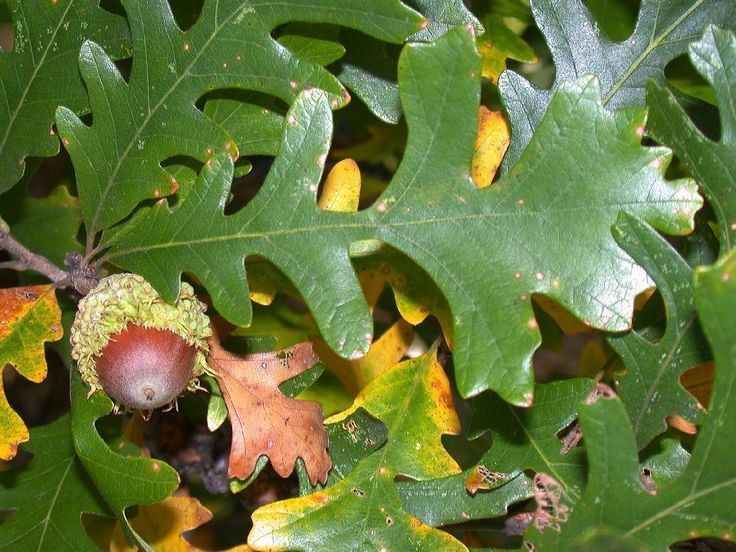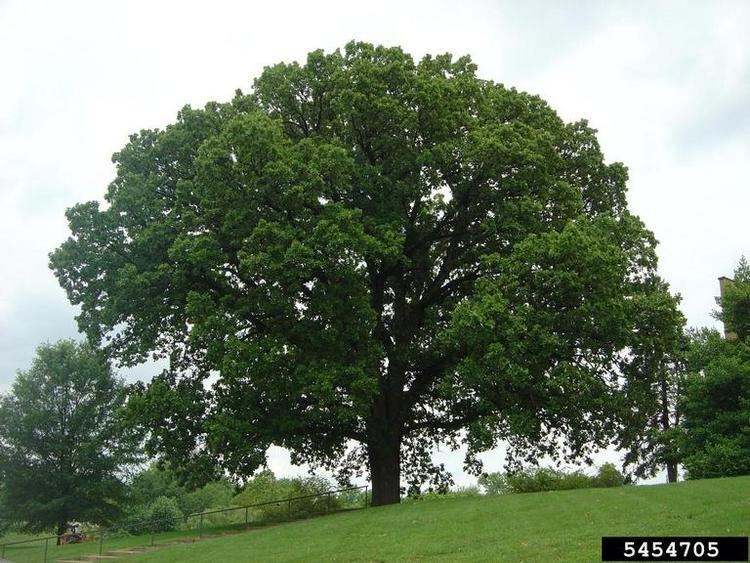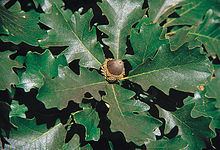Section Quercus Higher classification Oak Symbol of Iowa | Genus Quercus Scientific name Quercus macrocarpa Rank Species | |
 | ||
Similar Oak, Quercus bicolor, Swamp Spanish oak, Quercus velutina, Quercus muehlenbergii | ||
Quercus macrocarpa
Quercus macrocarpa, the bur oak, sometimes spelled burr oak, is a species of oak in the white oak section Quercus sect. Quercus, native to North America in the eastern and central United States and eastern and central Canada. This plant is also called mossycup oak and mossycup white oak.
Contents
- Quercus macrocarpa
- Awesome acorn of quercus macrocarpa
- Description
- Ecology
- Uses
- Cultivation
- Cultural
- Chemistry
- References

Quercus macrocarpa is widespread in the Atlantic coastal plain from New Brunswick to North Carolina, west as far as Alberta, eastern Montana, Wyoming, and northeastern New Mexico. The vast majority of the populations are found in the eastern Great Plains, the Mississippi/Missouri/Ohio Valley, and the Great Lakes region.

Awesome acorn of quercus macrocarpa
Description

Quercus macrocarpa is a large deciduous tree growing up to 100 ft (30 m), rarely 130 ft (40 m), in height, and is one of the most massive oaks with a trunk diameter of up to 10 ft (3 m); reports of taller trees occur, but have not been verified. It is one of the slowest-growing oaks, with a growth rate of 1 ft (30 cm) per year when young. A 20-year-old tree will be about 20 ft (6 m) tall if grown in full sun. Naturally occurring saplings in forests will typically be older. It commonly lives to be 200 to 300 years old, and may live up to 400 years. The bark is a medium gray and somewhat rugged.

The leaves are 3–6 in (7–15 cm) long and 2–5 in (5–13 cm) broad, variable in shape, with a lobed margin. Most often, the basal 60% is narrower and deeply lobed, while the apical 40% is wider and has shallow lobes or large teeth. The flowers are greenish-yellow catkins, produced in the spring. The acorns are very large, 0.75–2 in (2–5 cm) long and 0.75-1.5 in (2–4 cm) broad, having a large cup that wraps much of the way around the nut, with large overlapping scales and often a fringe at the edge of the cup.
Bur oak is sometimes confused with overcup oak and white oak, both of which it occasionally hybridizes with.
The acorns are the largest of any North American oak (thus the Latin species name macrocarpa—large fruit), and are an important wildlife food; American black bears sometimes tear off branches to get them. However, heavy nut crops are borne only every few years. In this evolutionary strategy, known as masting, the large seed crop every few years overwhelms the ability of seed predators to eat the acorns, thus ensuring the survival of some seeds. Other wildlife, such as deer and porcupine, eat the leaves, twigs and bark. Cattle are heavy browsers in some areas. The bur oak is the only known foodplant of Bucculatrix recognita caterpillars.
Ecology
Bur oak typically grows in the open, away from forest canopy. For this reason, it is an important tree on the eastern prairies, often found near waterways in otherwise more forested areas, where there is a break in the canopy. It is a fire-resistant tree, and possesses significant drought resistance by virtue of a long taproot. New trees, after two to three years of growth, may have a 1–2 m deep taproot. The West Virginia state champion bur oak has a trunk diameter of almost 3 m (9 feet).
The bur oak is among the most fire-tolerant tree species. One of its most common habitats, especially in Midwestern United States, is the oak savanna, where fires often occurred in early spring or late fall, especially in hill country.
Uses
The wood is of high quality, and is almost always marketed as "white oak".
Cultivation
Quercus macrocarpa is cultivated by plant nurseries for use in gardens, in parks, and on urban sidewalks. Bur oak makes an outstanding ornamental tree. Among the white oaks, it is one of the most tolerant of urban conditions, and is one of the fastest-growing of the group. It has been planted in many climates, ranging northwards to Anchorage, Alaska, and as far south as Mission, Texas. It withstands chinook conditions in Calgary, Alberta.
Cultural
The name sometimes is spelled "burr oak", as for example in Burr Oak State Park in Ohio, the city of Burr Oak, Kansas, the village of Burr Oak, Michigan, and in the title Burr Oaks by poet Richard Eberhart.
The bur oak is the state tree of Iowa. A burr oak is displayed on the revised seal and flag of Ann Arbor, Michigan.
Chemistry
The dehydrated tergallic acid C-glucoside and tergallic acid O-glucoside can be characterised in the acorns of Q. macrocarpa.
